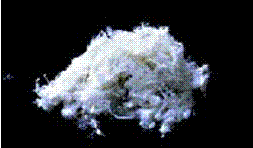What does asbestos look like?
There are 2 basic states of asbestos that are easy to identify:
- Bonded asbestos, which is a material that contains asbestos and cannot be crushed by hand, typically cement (asbestos cement, or AC). Flat AC is also referred to as fibro.
- Friable asbestos, which is a material that is in the form of a powder or is of a soft nature that is easy to crumble by hand when dry. This would result in airborne dust – typically pipe insulation, boiler insulation or damaged A/C (asbestos cement).
What should I do if I find asbestos in my house?
Do not disturb it under any circumstances. Instead, isolate the asbestos (or the area surrounding) with plastic and duct tape.
Contact a Hygienist to inspect and identify the substance
Contact P&D Envirotech on 1300 884 113 to have the asbestos safely removed.
Bear in mind that asbestos does not necessarily need to be removed when it is identified — however, if it begins to crumble or is disturbed (e.g. from excavation) then it becomes a health risk and must be removed. Regardless, it is strongly advised that you consult P&D Envirotech if you positively identify the presence of asbestos in your house or building.
How do I know if my house has asbestos in it?
If your house or property was constructed before the early 1980s, there is a good chance that it contains asbestos. If you are unsure, do not disturb any of these areas and seek the advice of P&D Envirotech or WorkCover.
Can I remove it myself?
If you own the property on which the asbestos has been found, and the property is in New South Wales (Australia) you can remove 10m2 and no more. However, it is recommended that you do not disturb the substance and contact P&D Envirotech.
Why is asbestos dangerous?
Asbestos becomes dangerous when the fibres are breathed into the lungs, which can lead to a number of asbestos-related diseases such as mesothelioma, benign pleural disease, asbestosis, and lung cancer. If the asbestos materials remain undisturbed and are maintained in good condition, the likelihood of the fibres being released into the air is significantly reduced.
If asbestos is so dangerous, why did we ever use it in the first place?
Asbestos is particularly effective for use in fireproofing and insulation. In the early 20th century, asbestos was the most popular material for fireproofing and insulation as it was cheap and readily available. Because of these conveniences, most (and eventually, all) buildings erected up until the late 70’s and early 80’s contained asbestos.
What happens to asbestos once it has been removed by professionals?
Asbestos materials are secured by double-wrapping in thick plastic and sealed off. It is then transported via licensed EPA carriers to a licensed landfill.
Do you need a license to remove asbestos?
The law in New South Wales (Australia) allows for a property owner to remove 10m2 and no greater from their property. In every other case, a license is required. The law also stipulates that workers for a licensed removal company must also have the appropriate asbestos removal training & supervision.
Every licensed asbestos removal job over 10m2 must have a clearance inspection carried out and a subsequent clearance certificate issued.
If I have asbestos in my house, does that mean I'm going to die?
If you identify airborne asbestos in your house or living space, it is highly recommended that you consult a doctor or physician immediately. Being in the vicinity of asbestos does not guarantee health problems or mortality, however it does put you at risk of asbestosis and mesothelioma, and if you are a smoker, your risk of these diseases is 10 times higher.
Where am I likely to find asbestos?
The most common places to find asbestos are in the bath, laundry, kitchen, lining of the eaves, roofs and walls, and water pipes. You may also find asbestos in old hot water systems and electrical meter boards. Subsoil contamination is also common, mainly from when the building was concreted.
Are there any uses for asbestos?
In modern times, the only use for asbestos is landfill.
What is the law about asbestos?
WorkCover regulations stipulate that all forms of asbestos are prohibited from commercial use. However, due to the fact that most properties constructed before the early 1980’s contain asbestos, the presence of asbestos is not illegal. However homes built as late as 1993 have been reported to contain asbestos product though the production of asbestos containing products become illegal in 1987. If the asbestos material remains undisturbed, its removal is not immediately necessary. This does not mean that it should not be removed, but the health risk is minimal in this condition, and a consultation from your fully licensed professionals, P&D Envirotech, is recommended.
How is lead paint different from other paint?
All types of paint available these days contain no lead. In essence, lead paint is an outdated product, due in large part to the toxic dangers it presents.
Where am I likely to find lead paint?
A house built prior to the 1970s is likely to contain lead-based paint, as are industrial and commercial buildings. You may also find lead paint in protective coatings for industrial equipment and buildings, some vehicle coatings (automotive or marine). There are also some specialised paints that may contain lead, such as on painted signs.
Is lead paint found in private residential buildings or commercial/industrial buildings?
Generally both. Old houses are likely to have been painted with lead-based coats. Old industrial buildings have a similar likelihood, especially around protective coatings and plant or industrial equipment.
What equipment is involved for removing lead paint?
To safely remove lead paint, among the equipment required are: a HEPA vacuum cleaner, chemical stripping equipment and an abrasive blaster (with dust control).
Why is there lead in paint?
Lead was used as a binding agent which thickened the paint rather effectively. The harmful effects of lead were not discovered until more recent times, and the use of lead paint was discontinued in the 1970s.
What makes lead paint dangerous?
The lead in lead paint has a cumulative toxic effect. When exposed via inhalation, skin contact, or ingestion, the lead is distributed throughout the body and remains in the bones, organs and bloodstream as a constant source of internal toxic exposure. Lead paint is dangerous because, after time, it can chip or crumble, releasing airborne particles of lead.
How would I recognise lead paint?
The easiest way to find out is to check when the property or machinery was last painted. If it was last painted during the 1970s or before, then you stand an excellent chance of having lead-based paint in your house.
Are there other types of paint?
There is a diverse range of paint products commercially available for all manner of applications, none of which contain lead.
If I find lead paint in my building, am I in danger?
As most lead paint is old these days, it is likely to be peeling, crumbling or chipping away. If you find lead paint in this condition, then yes, there is a possible danger. In any case, if you discover lead paint in your premises, it is a good idea to contact P&D Envirotech for the best advice.
What is the law about lead paint?
IN NSW, the NSW WorkCover Code of Practice for the Control of Hazardous Substances requires occupational lead hazards to be controlled and specifies the requirements for the labelling, storage, transport and disposal of lead materials and waste. For Australia-wide law, refer to the National Code of Practice for the Control and Safe Use of Inorganic Lead at Work.
If I find lead paint and do nothing about it, is that illegal?
Potentially, yes. According to the Work Health Safety Act 2011, a material containing more than 1% lead is deemed hazardous, and employers have a duty of care to provide a safe working environment. In a domestic situation, you could find yourself in legal trouble, especially if you are leasing a property to someone. However, the inherent health risks should be enough incentive to take action.



